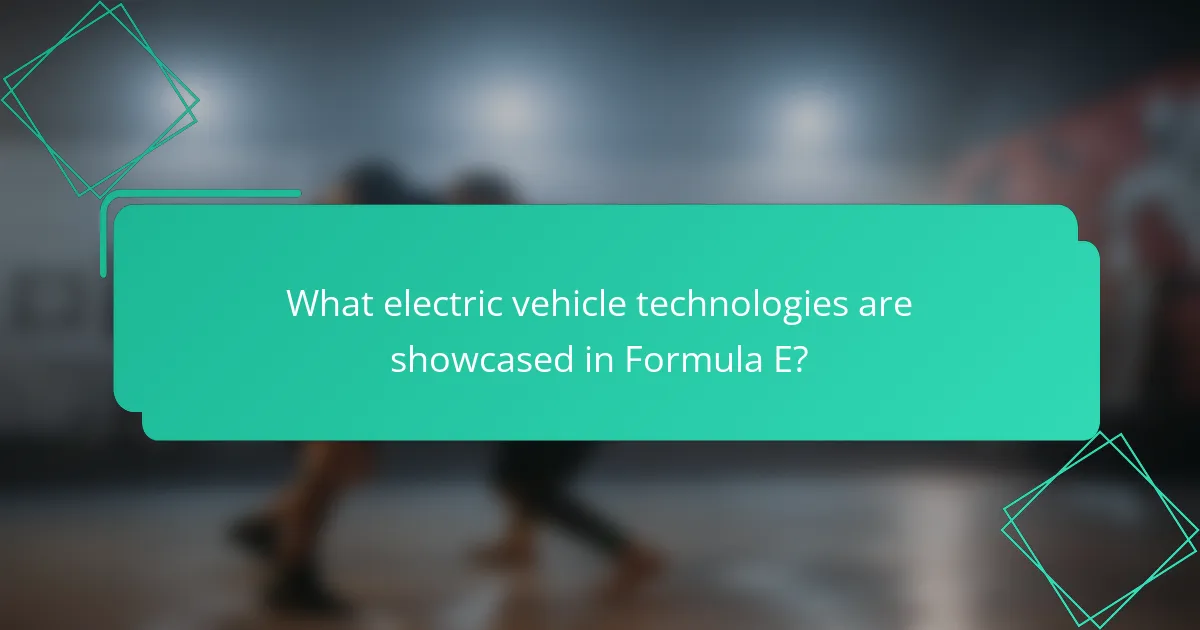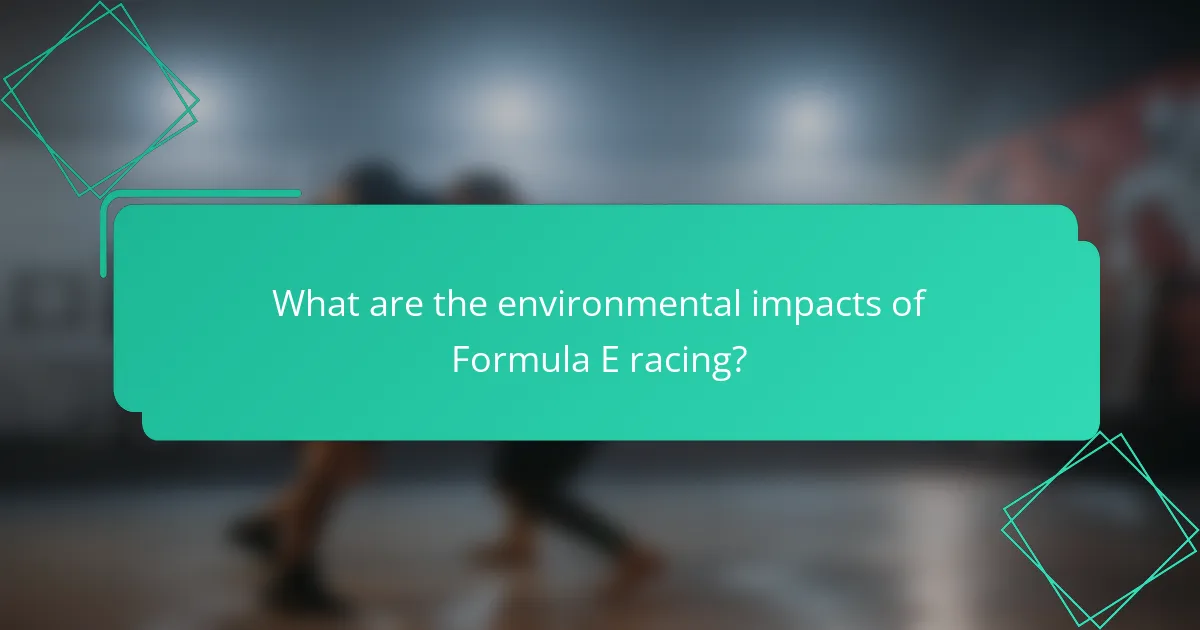Discover the excitement of the 2025 Formula E season, featuring key locations like Cape Town and New York City. Learn about the ten competing teams, including Mercedes-Benz EQ and Jaguar TCS Racing. Explore cutting-edge electric vehicle technologies that enhance performance and sustainability. Understand the fan engagement initiatives that create an interactive racing experience.

What are the key locations for the 2025 Formula E races?
The key locations for the 2025 Formula E races include cities known for their commitment to sustainability and electric mobility. Notable venues are Cape Town, London, and New York City. Other cities may include Berlin, Monaco, and São Paulo. Each location showcases unique urban circuits designed to highlight local landmarks while promoting electric vehicle technology.
How do city circuits differ from traditional race tracks?
City circuits differ from traditional race tracks by featuring temporary street layouts in urban areas, emphasizing tight turns and shorter straights. This design enhances the challenge for drivers and increases spectator engagement. Traditional tracks are permanent, often with longer straights and wider corners, allowing for higher speeds. City circuits promote sustainability and accessibility, aligning with Formula E’s electric vehicle focus.
Which cities are hosting Formula E races for the first time in 2025?
In 2025, Formula E will host races for the first time in cities including Cape Town, Vancouver, and São Paulo. These locations expand the championship’s global footprint and enhance its commitment to sustainability. Each city will showcase unique urban landscapes, contributing to the diverse racing experience.
What are the logistical challenges of racing in urban environments?
Urban racing presents logistical challenges such as traffic congestion, limited space, and noise regulations. These factors complicate race planning and execution. Additionally, securing permits and ensuring safety for both participants and spectators are critical. Urban environments often require intricate circuit designs that navigate through busy streets, which can increase costs and logistical complexity.

Which teams are competing in the 2025 Formula E season?
The 2025 Formula E season will feature ten teams competing for the championship. These teams include prominent names such as Mercedes-Benz EQ Formula E Team, DS Automobiles, and Jaguar TCS Racing. Each team will field two drivers, showcasing cutting-edge electric vehicle technology. Additionally, the season promises thrilling races across diverse international locations.
How do team structures influence race performance?
Team structures significantly influence race performance by enhancing communication and collaboration. Effective team dynamics lead to better strategy execution and quicker decision-making. For example, teams with clear roles and responsibilities can optimize vehicle setups and race strategies. Additionally, the synergy between drivers and engineers is crucial; teams that foster strong relationships often see improved performance on the track. The unique attribute of Formula E teams is their focus on electric vehicle technology, which requires specialized knowledge and innovative approaches to maximize efficiency and speed.
What unique strategies do different teams employ?
Different teams in Formula E employ unique strategies based on their strengths and goals. For instance, some prioritize energy management to maximize performance throughout the race. Others focus on aggressive overtaking tactics to gain positions quickly. Teams like Audi Sport ABT Schaeffler emphasize technical innovation, leveraging advanced software for real-time data analysis. Meanwhile, Jaguar Racing capitalizes on driver skill and teamwork to enhance race execution. Each team’s approach reflects their distinct attributes and competitive objectives in the electric racing landscape.
Which teams have the most successful histories in Formula E?
The most successful teams in Formula E history include Audi Sport ABT Schaeffler, DS Techeetah, and Jaguar Racing. Audi has secured multiple championships, while DS Techeetah boasts several team and driver titles. Jaguar Racing has shown consistent performance, contributing to its growing reputation.

What electric vehicle technologies are showcased in Formula E?
Formula E showcases cutting-edge electric vehicle technologies, including battery management systems, regenerative braking, and advanced aerodynamics. These innovations enhance performance and efficiency in racing. Notably, the series emphasizes the use of sustainable materials and energy recovery systems, driving advancements in the broader electric vehicle industry.
How do battery technologies impact race outcomes?
Battery technologies significantly influence race outcomes in Formula E by affecting vehicle performance and strategy. Advanced battery systems enhance energy efficiency, allowing teams to optimize their race pace and pit strategies. The energy density and charging speed of batteries determine how quickly drivers can regain power, impacting their ability to overtake rivals. For instance, teams with superior battery management can maintain higher speeds for longer durations, leading to better race results. Furthermore, the development of lightweight battery solutions contributes to overall vehicle agility, which is crucial in tight racing scenarios.
What innovations have been introduced in 2025?
In 2025, Formula E introduced significant innovations, including advanced battery technologies, enhanced safety features, and new race formats. These changes aim to improve performance and sustainability in electric racing. Notably, the introduction of faster charging stations allows for shorter pit stops, enhancing race dynamics. Additionally, the integration of AI for real-time data analysis improves team strategies during races.
How does regenerative braking work in Formula E vehicles?
Regenerative braking in Formula E vehicles converts kinetic energy into electrical energy during braking. This process enhances efficiency and extends battery life. When drivers apply brakes, the electric motor reverses its function, acting as a generator. This captures energy that would otherwise be lost as heat, storing it back in the battery for later use. Consequently, regenerative braking plays a crucial role in optimizing race performance and energy management in Formula E.

How do fan engagement and participation shape the Formula E experience?
Fan engagement and participation significantly enhance the Formula E experience by fostering community and excitement. Events like fan zones and interactive activities allow spectators to connect with teams and drivers. The integration of digital platforms enables real-time interaction, making fans feel part of the race. Unique features, such as fan voting on race strategies, deepen involvement. As a result, these elements create a vibrant atmosphere that amplifies the overall enjoyment of the event.
What role do social media platforms play in fan interaction?
Social media platforms enhance fan interaction by facilitating real-time communication and engagement with Formula E events. Fans can follow teams, share experiences, and participate in discussions, creating a vibrant community. Platforms like Twitter and Instagram provide updates on race schedules, team performances, and electric vehicle insights, fostering a deeper connection between fans and the sport. This interaction encourages loyalty and increases overall viewership.
How are fans influencing team and driver decisions?
Fans significantly influence team and driver decisions in Formula E by expressing preferences through social media and engagement. Their feedback impacts team strategies, driver selections, and sponsorship choices. For example, popular drivers often receive more support, shaping team dynamics. Additionally, fan voting on certain initiatives can lead to changes in race formats or locations, reflecting audience interests and enhancing viewer experience. This interaction fosters a more engaged community and aligns team goals with fan expectations.

What are the environmental impacts of Formula E racing?
Formula E racing has a lower environmental impact compared to traditional motorsports due to its focus on electric vehicles. The series promotes sustainability through renewable energy use and urban racing locations, minimizing land disruption. Additionally, Formula E aims to raise awareness of electric mobility and its benefits, contributing to environmental conservation.
How does Formula E contribute to sustainability in motorsports?
Formula E significantly contributes to sustainability in motorsports by promoting electric vehicle technology and reducing carbon emissions. The series operates in urban locations, minimizing travel distances and encouraging public transport use. Additionally, each race utilizes renewable energy sources, with a commitment to achieving a net-zero carbon footprint. Formula E also engages in initiatives such as tree planting and community programs, further enhancing its positive environmental impact.
What are the carbon offset initiatives associated with the races?
Formula E races incorporate various carbon offset initiatives aimed at promoting sustainability. These initiatives include tree planting programs, renewable energy projects, and partnerships with environmental organizations. Each race location often features local carbon offset projects that align with the event’s commitment to reducing its environmental impact. As a result, Formula E not only showcases electric vehicles but also actively contributes to global carbon neutrality efforts.

What are the key rules and regulations governing Formula E races?
The key rules and regulations governing Formula E races include adherence to safety standards, technical specifications for electric vehicles, and race format guidelines. Teams must comply with the FIA’s regulations, which cover aspects such as vehicle design, energy management, and driver conduct. Each race features a unique location, with circuits designed for street racing, enhancing the challenge for drivers. Additionally, teams are limited in the number of cars and components they can use throughout the season, promoting sustainability and competition.
How do race formats differ from other motorsport events?
Formula E race formats emphasize electric vehicle performance and sustainability, differing significantly from traditional motorsport events. They feature street circuits in urban environments, fostering close competition and fan engagement.
Key differences include race duration, typically around 45 minutes, and the use of energy management strategies. Teams consist of manufacturers and private teams, enhancing diversity. Formula E prioritizes sustainability, with all-electric vehicles, contrasting with combustion engines in other motorsports.
The championship’s unique attribute is its focus on renewable energy and innovation, making it distinct in the racing landscape.
What penalties are commonly enforced during races?
Common penalties during Formula E races include time penalties, drive-through penalties, and disqualifications. These penalties ensure fair competition and adherence to race regulations. Time penalties typically add seconds to a driver’s overall time for infractions, while drive-through penalties require drivers to enter the pit lane and drive through without stopping. Disqualifications are enforced for severe violations, removing a driver from the race entirely. These measures maintain the integrity of the sport and promote safety.

What are the upcoming trends in electric vehicle racing?
Upcoming trends in electric vehicle racing include increased participation, innovative technologies, and sustainability initiatives. The Formula E race schedule features diverse locations and teams, showcasing advancements in electric vehicle performance. New battery technologies promise longer race durations and faster charging times. Enhanced aerodynamics and lightweight materials are set to improve vehicle efficiency. As electric vehicle racing grows, collaborations with automotive manufacturers will likely expand, driving further innovation.
How is Formula E influencing the broader automotive industry?
Formula E significantly influences the automotive industry by accelerating the adoption of electric vehicle technology. The series showcases advanced EV innovations, pushing manufacturers to enhance performance and sustainability.
Notably, Formula E has prompted major automakers to invest in electric powertrains, fostering competition in the EV market. The collaboration between teams and automotive brands leads to breakthroughs in battery efficiency and energy management.
As a result, the insights gained from racing conditions are applied to consumer vehicles, enhancing overall EV appeal. This synergy between motorsport and commercial automotive sectors drives consumer interest and acceptance of electric mobility.
What advancements can we expect in electric vehicle technology in the next few years?
Significant advancements in electric vehicle technology are expected in battery efficiency, charging speed, and autonomous driving features. Innovations will likely include solid-state batteries with higher energy density, enabling longer ranges and faster charging. Enhanced software integration will improve vehicle performance and user experience. Additionally, advancements in vehicle-to-grid technology will allow EVs to contribute to energy management systems.
How can fans prepare to attend a Formula E race in 2025?
Fans can prepare to attend a Formula E race in 2025 by planning logistics, understanding the schedule, and familiarizing themselves with teams and vehicles. First, check the race schedule for specific dates and locations. Next, consider transportation options to the venue, including public transport and parking availability. It’s also beneficial to research the participating teams and their electric vehicles, as this enhances the overall experience. Lastly, purchasing tickets in advance ensures entry and may offer better seating options.
What are the best practices for maximizing the race day experience?
To maximize the race day experience, plan ahead, arrive early, and engage with activities. Familiarize yourself with the Formula E race schedule, including locations and teams. Utilize electric vehicle insights to enhance your understanding of the technology. Stay hydrated and dress for the weather to ensure comfort throughout the event.


